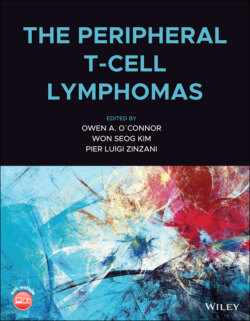Читать книгу The Peripheral T-Cell Lymphomas - Группа авторов - Страница 98
Anaplastic Large‐cell Lymphoma
ОглавлениеALCL accounts for approximately 12% of T‐cell lymphomas and approximately 2% of all NHLs [10, 34]. It is the third most common PTCL in adults in the United States and has an estimated incidence of 0.25 cases per 100 000 people [25]. The cell of origin is thought to be mature activated cytotoxic T‐cells that are CD30+. Based on molecular characterization and clinical features, four distinct forms of ALCL are recognized: (i) primary systemic ALCL, ALK+ ALCL; (ii) primary systemic ALCL, ALK– ALCL; (iii) primary cutaneous ALCL; and (iv) BIA‐ALCL.
In the international T‐cell lymphoma project, which is the largest retrospective study conducted in the disease, approximately 6.6% and 5.5% of cases were classified as ALK+ and ALK– ALCL, respectively [10]. ALCL was the most common PTCL subtype in the United States, accounting for approximately 24% of all cases. In the United States, Asian American are known to have a lower incidence of ALCL than White Americans, American Indians, African Americans, or Asian Pacific Islanders [18, 35].
ALK+ ALCLs have a median age incidence of 33–34 years whereas ALK– ALCLs have a median age of 58 years [10, 36]. In older adults, ALCL is typically ALK–. Male predominance is generally seen, and in young patients with ALK+ ALCL, the male to female ratio may be as high as three to one [37].
People with a history of celiac disease [38], those under 30 years, those with a history of eczema, and those with a history of cigarette smoking, people 30 years and older with a history of psoriasis, occupation as electrical fitter or textile worker, all have an increased risk of the disease [20]. EBV was originally thought to be associated with the development of this disease, but this finding has been subsequently reported not to be true [39]. HIV, however, does continue to remain a risk factor particularly for ALK– ALCL [40].
BIA‐ALCL was added as a provisional entity in the new WHO classification. The exact incidence is not known. Although earlier or later presentations can be seen, most cases are known to present approximately one decade after implant placement. The median age of onset is approximately 50 years of age [41, 42]. Other implanted medical devices other than breast implants are not known to cause ALCL.
Although the absolute risk for development of BIA‐ALCL is low in women with breast implants, there is a high relative risk compared with the general population, as demonstrated in a population‐based case–control study from the Netherlands (approximately nine million women) which reported an 18‐fold higher rate of ALCL arising in the breast among women with breast implants compared with women who did not have implants [43]. The reason for implant placement (cosmetic versus reconstructive) does not seem to influence the risk of lymphoma [44].
